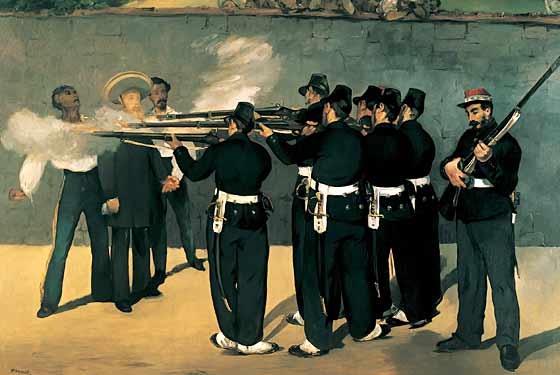
I n 1864, Napoleon III of France, tantalized by imperial dreams, appointed a Habsburg duke named Maximilian as the emperor of Mexico. A civil war erupted, and, traumatized, the French skedaddled. They left behind Maximilian, whom the Mexicans executed in 1867 with two of his generals. The bumbling misadventure infuriated the proud French, among them the staunch republican Édouard Manet, who loathed the autocratic Napoleon III. Between 1867 and 1869, he painted several versions of the execution, now on view in a provocative show at MoMA. The exhibit is best approached as a meditation upon political art, but any allusion to 2006, says its organizer, John Elderfield, is entirely intentional.
Great political art, especially about modern barbarism, is extraordinarily rare. It’s almost impossible to create a picture with the right moral measure. Many people argue, for example, that the imagination cannot finally fathom the Holocaust; art founders before the fact. Other instances of human horror aren’t much easier to represent. An artist can stun viewers with documentary evidence of brutality, of course, but that usually appears manipulative and too easy—an abandonment of art’s shaping powers. Too fine an aesthetic effect, however, seems grossly misplaced. And moral grandstanding is repugnant. In the history of painting, there are only three modern works that truly rise to the occasion, the first and greatest being Goya’s The Third of May, 1808: The Execution of the Defenders of Madrid. Picasso’s Guernica, his black-and-white response to the Fascist bombing of the Spanish town, is another. And Manet’s final version of The Execution of Emperor Maximilian is the third.
Manet surely sensed the difficulty in treating the subject, for he restlessly made three large paintings of the execution (along with a smaller painting and lithograph). The group is now being hung together on one central wall, inviting analysis of how the image evolved; each picture differs from the next, and the last is the best. Related materials—such as archival photographs of the execution and several other Manets, among them The Dead Toreador—are also on view. As he set out to paint the execution, Manet had much on his mind in addition to his anger at Napoleon III. The genre of history painting, which depicts important events real and imagined, was then steeped in bombast: slickly painted forms, grandiloquent arrangements, high-flown moralizing. In comparison, Goya’s The Third of May, 1808, which the French artist admired, was a howl of truth.
Manet’s first large Execution is sketchy, dark, and jumbled, as if an air of visual turmoil were necessary to capture the violence at hand. He was probably dissatisfied with the picture, if his next two large images are any indication. Whereas Goya and Picasso made use of hot, screaming outrage, the paradoxical Manet, who had about him much of the reserved dandy, was not a shouter. He had one of the most elusive, and exquisitely subtle, sensibilities in nineteenth-century art—at once warm and cool, detached and sensual, sweet and brutal. In his next two large works, his image clarifies, becoming sharper in form and cooler in feeling. He seems to strip down history painting, removing its many filters and veneers, much as he had stripped the conventions of “the nude” in Olympia to reveal a naked woman.
In the catalogue, Elderfield makes some astute observations about the role of time in Execution (which are also true of the Goya and Picasso works): The execution has both the shocking immediacy of the present and the timeless ripple of implication and reflection. Violence co-exists with contemplation. Like Goya, Manet presses the muskets into the flesh with spitting intimacy. The prisoners clutch hands; each has a different expression, with Maximilian already growing pale and haloed. The smoke unites the two kinds of time—shock becomes reverie, the present drifts into the future. The innuendoes of the painting seem unending. (The soldier with the upraised gun, our representative, already appears to be thinking.) The wall in the background, which replaced an open landscape in the damaged second version of the picture, is strangely flattening; it suggests the inescapable abstraction of modern violence. The faceless firing squad has the implacable aspect of a turned back. The blurry figures looking down from the wall could be Baroque statuary or the modern crowd. You cannot finally contain the meanings in Execution, just as you cannot finally know why men do what they do.
Manet and the Execution of Maximilian
Museum of Modern Art. Through January 29.